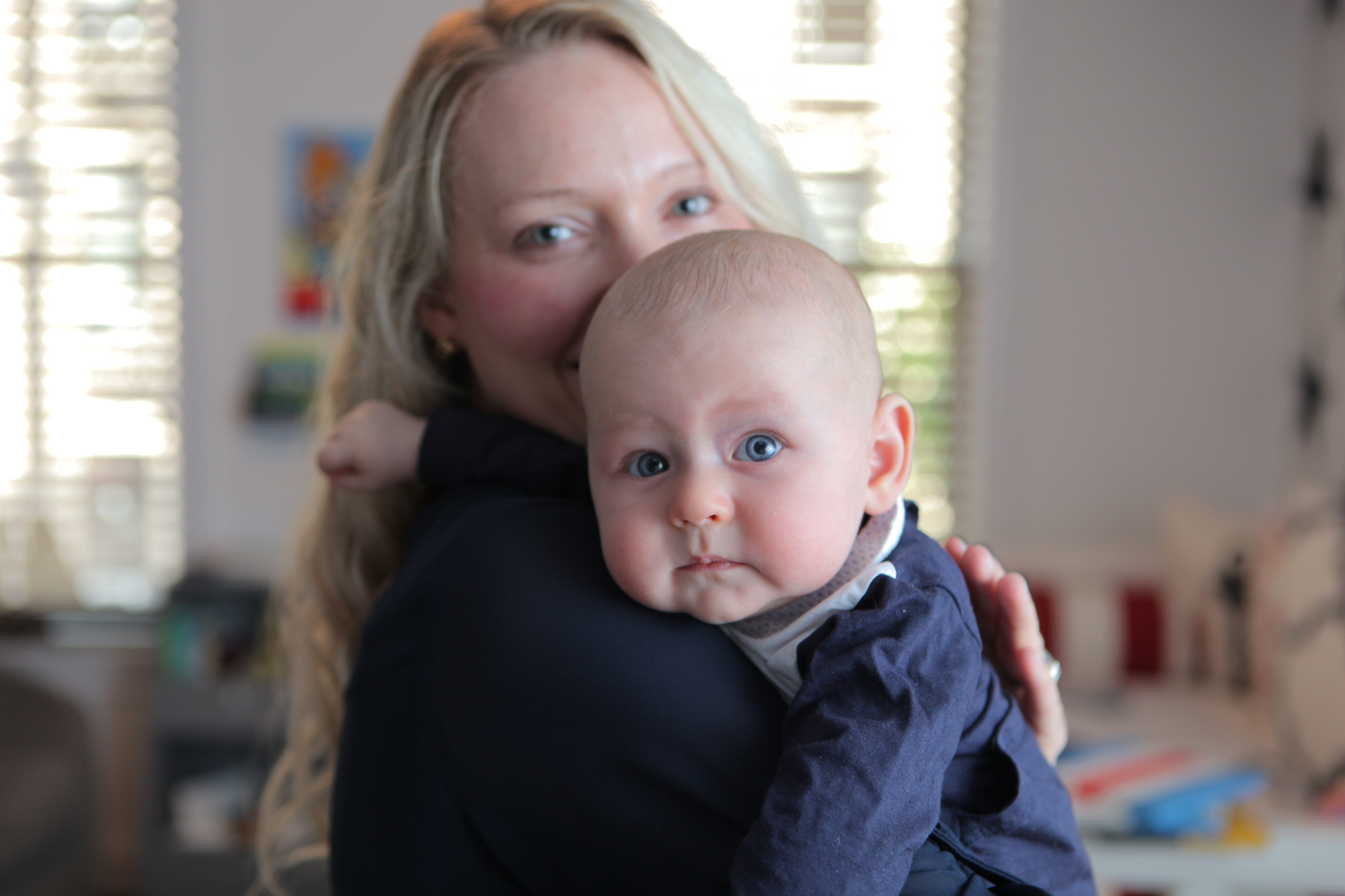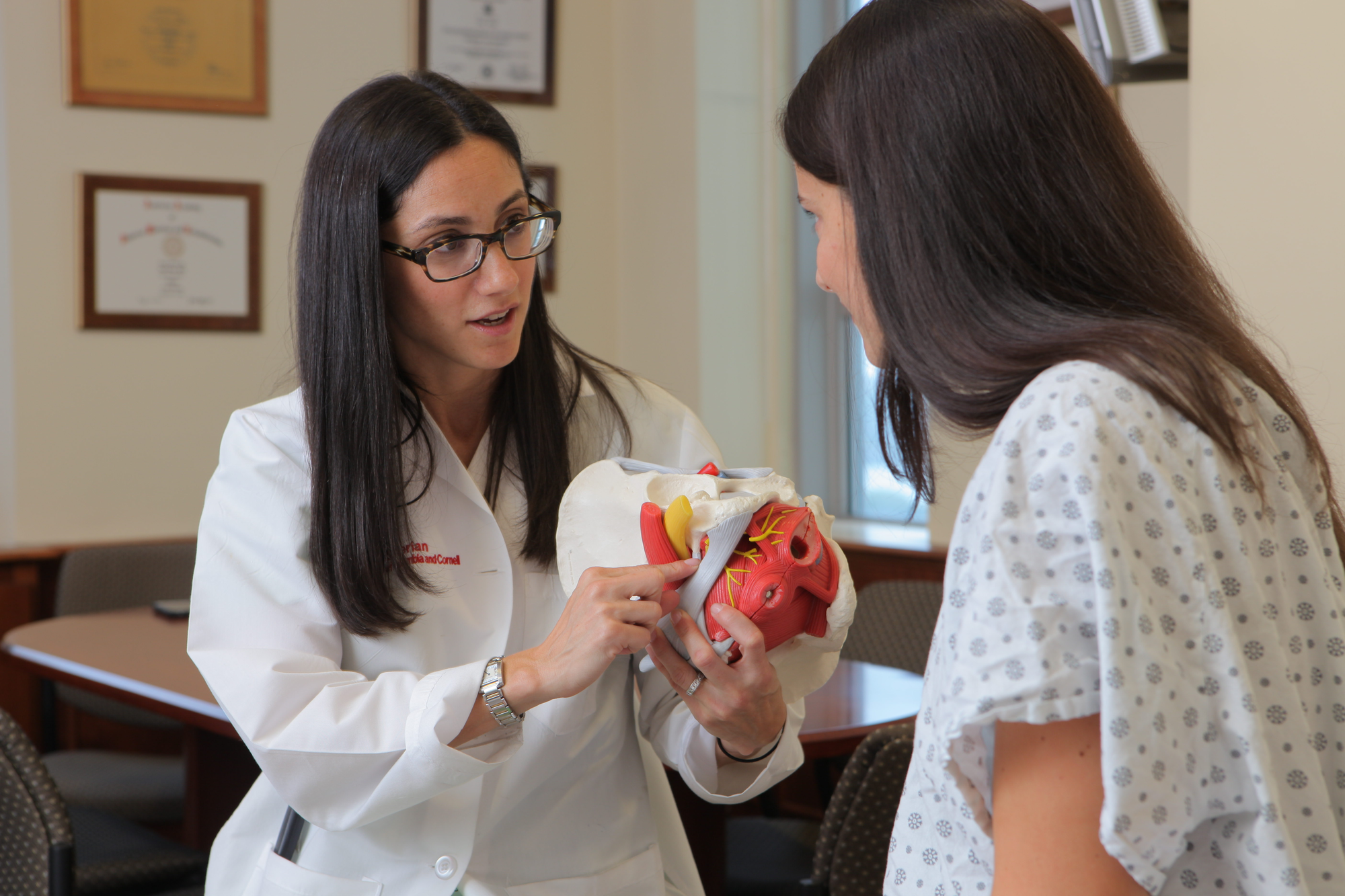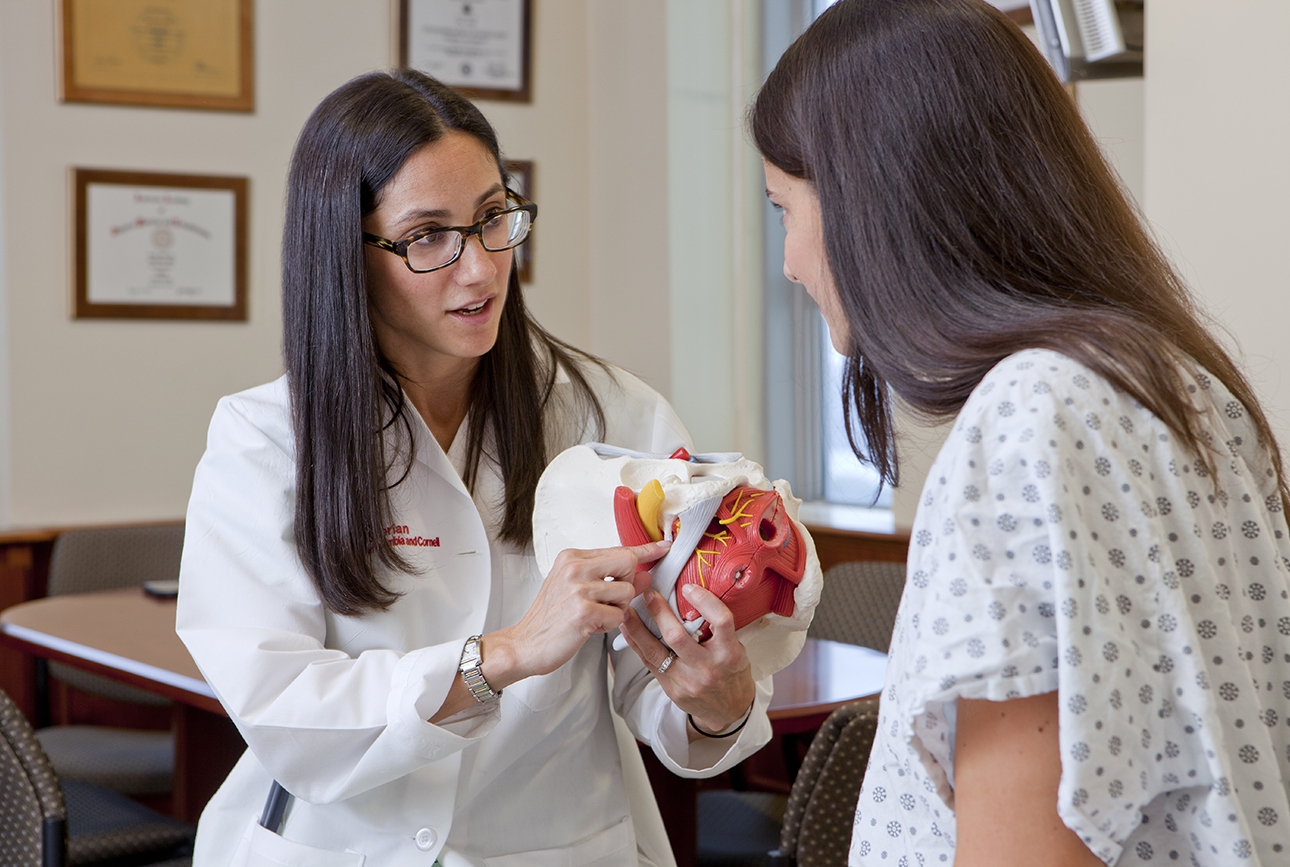Physiatrist Dr. Jaclyn Bonder specializes in the rare field of rehab for women with pelvic floor disorders and other ob/gyn-related issues
By Beth Saulnier
Portraits by John Abbott
Carter Bisso was about 20 weeks pregnant when the pain started — an ache on the right side of her lower back, between her hip and spine. It got worse and worse, to the point where she couldn't sleep at all. "I would lay down and the pain was absolutely agonizing," recalls Bisso, a marketing professional who lives in the West Village. "When you're in that much pain, the nights are endless. Sitting also hurt, so I would stand and kind of sway at the kitchen counter and try to stay awake. I was almost delirious."
An assistant professor, Dr. Bonder is one of just a dozen physicians nationwide who specialize in women's health rehabilitation with a pelvic floor and ob/gyn focus. She treats numerous pregnant and postpartum patients with musculoskeletal problems, as well as those with other conditions related to pelvic floor muscle dysfunction and weakness including chronic pelvic pain, urinary and bowel issues, pain following gynecologic surgery, pain during intercourse, and pain in the lower back, groin, abdomen and hips. Zeroing in on diseases and conditions using specialized exam techniques as well as conventional diagnostic methods, she treats patients using a wide range of modalities including physical therapy, oral medications, injections of pain drugs, hormone therapy, and topical medications.Bisso's ob/gyn said she could try an over-the-counter sleep aid, but it didn't help; neither did a visit to a pain-management specialist. When she went for an ultrasound at 31 weeks, she recalls, "the tech was trying to be supportive, and he said, 'Only nine weeks to go,' and I burst into tears. When you're in that kind of pain, any amount of time is too long." Finally, she called her ob/gyn's practice again to ask for a referral to a physical therapist. But one of the nurses had a different suggestion, someone she'd seen during her own pregnancy: Dr. Jaclyn Bonder, medical director of women's health rehabilitation in the Division of Rehabilitation Medicine at Weill Cornell Medicine and the Department of Physical Medicine and Rehabilitation at NewYork-Presbyterian/Weill Cornell Medical Center.

Happy ending: Carter Bisso with her son, Cal.
"When I went to her, it was remarkable," Bisso recalls. "I told her roughly where the pain was, and she pointed to a spot on my back and asked, 'Is it right here?' — and it was the dead-on spot that was hurting." Dr. Bonder had Bisso lie down and raise each leg; the right one was harder to lift. "Then she leaned over and squeezed in on my hips and told me to lift my right leg again," Bisso says. "And it was almost as if it was air, it lifted so easily."
It turned out that Bisso's problem was primarily related to the sacroiliac joint, a pelvic joint in her buttock. Dr. Bonder explained the importance of wearing a pregnancy support garment commonly known as a "belly band" — which, despite its name, is more about reinforcing the joints of the pelvis as they loosen and the muscles stretch in preparation for birth. She also cautioned her against exercises that stretch and open the hips, which Bisso had been doing avidly in the mistaken belief that they might help, and offered advice for modifying her prenatal yoga routine. "Seeing her, that one visit, my life turned around," Bisso says. "I was so scared about my pregnancy, not being able to sleep. I didn't know how I was going to make it through to my delivery date, living in that kind of pain. One visit made such a difference, and now I've told all my pregnant friends about her. She was so patient and attentive and professional. It really was a wonderful experience."
Bisso — who gave birth to a healthy baby boy, Cal, in June — is just one of many patients who credit Dr. Bonder with helping them overcome pain and restore their physical function. For Dr. Bonder, who contemplated a career in physical therapy before applying to medical school, such outcomes are immensely satisfying. "When patients come to me, they've often lost hope," she says. "I find it really gratifying to keep digging, to think outside the box to try to figure it out. I put myself in their shoes and think how upset and miserable I'd be if I couldn't sit on the floor to play with my son or lift him out of the bath. Like any doctor, it feels great to make a patient feel better — to help give them back parts of their lives."
Dr. Bonder's path to her unusual specialty began with a postcard. During her residency in rehab medicine (also known as physiatry) at NYU, she got notice of a continuing medical education course at the Rehabilitation Institute of Chicago on rehab for women with pain and other musculoskeletal issues related to pregnancy and birth. Since she'd loved her ob/gyn clerkship during medical school and had a strong interest in women's health, it felt perfect for her — and her residency director agreed. In Chicago, she learned to perform a specialized procedure known as a musculoskeletal pelvic floor exam, an internal and external exam in which the physician assesses the status of the pelvic floor — the muscular base of the abdomen, attached to the pelvis — and related joints, muscles and nerves. Although it takes just 10 minutes or so, the exam is not routinely taught in medical school or post-graduate training.

'So relieved': Dr. Jaclyn Bonder with patient Julia Buldo-Licciardi
After doing additional training in Chicago during her residency, Dr. Bonder became one of the only physiatrists in New York who address conditions related to pelvic floor pain and dysfunction. She now gets referrals to treat patients, including men, with a wide range of symptoms and conditions. "She's a very caring physician and a wonderful colleague to work with," says Dr. Bilal Chughtai, an assistant professor of urology who specializes in treating women. "These are difficult cases in general, because these patients are often silent sufferers who've had their conditions for a long time. You've got to be very good at speaking to them and bringing it to the surface, because a lot of times they won't really talk to you about it. So it's important that you make patients comfortable."
One patient who struggled for years was Julia Buldo-Licciardi, a 26-year-old instructor who teaches undergrads at NYU. Years ago, when she was a ballet dancer, she tore a muscle in her hip — and that injury may or may not have contributed to a constellation of symptoms that started plaguing her three years ago including constipation, abdominal numbness, and vaginal pain.
Since all of Buldo-Licciardi's test results were unremarkable, she says, "everybody kept telling me I was fine," and she eventually sought mental health treatment on the assumption that the symptoms must be related to stress following the death of a close relative. "When I got Dr. Bonder's name, I was so relieved," says Buldo- Licciardi, who was referred by Dr. Orli Etingin, the Lisa and Sanford B. Ehrenkranz Professor in Women's Health and medical director of the Iris Cantor Women's Health Center. "When I got to her office, I felt like I was finally being taken care of. She actually knew what I was talking about, and she was completely in tune with all my symptoms. It wasn't like it was foreign dialogue to her."

Dr. Bonder and Buldo-Licciardi, herself an aspiring physician
Dr. Bonder prescribed a course of physical therapy — a combination of at-home exercises and sessions with a specialist in pelvic floor rehab — and the results have been excellent. Buldo-Licciardi's pain and numbness have abated and her gastrointestinal function is now normal. "I'm gaining more sensation in my abdomen and we're releasing the vaginal muscles in the pelvic floor, and that's alleviating a lot of the pain, so it's been incredible," she says. "I feel very lucky."
In the future, more patients may not need to count on luck to feel better. Dr. Bonder and a colleague at Columbia are surveying ob/gyn residents throughout the New York metro area on their knowledge of lower back and pelvic pain during pregnancy and after delivery, including their thoughts on when and how they'd offer treatment. The ultimate goal is to devise educational tools to make clinicians more aware of such conditions and their possible remedies. "Most obstetricians are not trained in what to do with these patients, because the symptoms are muscle and joint related, not necessarily gynecologic," Dr. Bonder says. "The natural inclination is to tell them, 'You've just delivered a baby, you've got some pain, it's normal, it's going to get better, just give it some time.' But that's not always the case. If you take 10 patients, it's probably true that most of them are going to get better — but if you don't do anything, the others may not, and may get worse. And the earlier you treat them, the likelier they are to get better."
Bisso improved so much from following Dr. Bonder's advice that she canceled a follow-up appointment. But she went back to see her about three months after giving birth, when she started to feel pain in the same area of her back. "I wanted to be preemptive," says Bisso, "and not wait until I couldn't sleep at night." It turned out to be just muscle strain, and the pain abated after Dr. Bonder suggested Advil and some stretching exercises. "I wish more women didn't just accept that we're supposed to suffer — and that there were more doctors like Dr. Bonder," Bisso says. "Especially in the third trimester, everyone says you're not going to sleep, you're counting down the days, you're almost expecting it to be rough. But in the end, that's not what it had to be for me."
This story first appeared in Weill Cornell Medicine, Vol. 14, No.3.

